Imagine, if you will, a tool that can help you automate sales and marketing activities—a means to automatically send out customer persona-specific email drip campaigns to new customers, generate reminders to your sales teams to follow up with hot leads, and even move your contacts from one lifecycle stage to another as they complete specific actions on your website.
Actually, you don’t have to because it already exists. It’s called HubSpot Workflows and it’s one of my personal favorite tools in the platform (next to the blog editor, naturally). What are HubSpot workflows, how do they help you save time and catch more leads (and, by extension, customers), and how can you use them?
Let’s answer these questions and more in Bluleadz’s Ultimate Guide to Using HubSpot Workflows!
Business Benefits of Using Workflows
So, why would you spend time learning the HubSpot Workflows tool and then setting up a bunch of workflows? Some of the benefits of using workflows in HubSpot include:
- Automating Communications. Workflows are a wonderful tool for automating both internal and external communications. This can be useful for doing things like ensuring that every new lead gets a welcome email or keeping your sales team aware of when they have hot leads that need to be followed up with.
- Saving Time. By automating communications, you can spend less time manually writing emails and curating email lists and more time on all of the other things you have to do in your day.
- Keeping Your Sales Pipeline Moving. Different leads have different needs at each stage of your sales pipeline. With a well-constructed series of workflows, you can ensure that appropriate content, information, and offers are sent to leads in your sales pipeline at each stage of the buyer’s journey. You can even use workflows to re-engage with lost deals or leads who have gone radio silent to get them back into your sales pipeline.
The benefit of time saved alone is reason enough to want to master the use of HubSpot workflows. It can save you hours of time every week on common email workflows and contact management. Over the course of a year, you could save yourself days or weeks of time compared to manually composing mass email sends and managing contacts.
Which Tiers of HubSpot Unlock Workflows?
Not every HubSpot portal will grant access to the HubSpot workflows tool. In order to access workflows, you need to have one of the following types of HubSpot Subscriptions:
- Marketing Hub. Professional or Enterprise level.
- Sales Hub. Professional or Enterprise level.
- Service Hub. Professional or Enterprise level.
- Operations Hub. Professional or Enterprise level.
How Much Will the Workflows Tool Cost?
The different HubSpot subscriptions have varying costs. The subscription tiers that unlock workflows have the following prices as of the time of this writing:
|
Hub Type |
Professional Cost |
Enterprise Cost |
|
Marketing |
$800/month |
$3,600/month |
|
Sales |
$450/month |
$1,200/month |
|
Customer Service |
$450/month |
$1,200/month |
|
Operations |
$720/month |
$2,000/month |
Note: The prices listed above are for when billing upfront annually. Month-to-month subscriptions may have a higher monthly cost.
Different types of HubSpot subscriptions have different features. This can affect how you use the workflows tool. Additionally, the workflows tool on your HubSpot portal will have different features depending on your subscription type.
|
Hub Type |
Professional Workflow Features |
Enterprise Workflow Features |
|
Marketing |
Up to 300 workflows for 10 teams. |
Up to 1,000 workflows for 300 teams. Added features for workflow health monitoring. |
|
Sales |
Up to 300 workflows for 10 teams, including quote-based workflows. |
Up to 1,000 workflows for 300 teams, including quote-based workflows and health monitoring. |
|
Customer Service |
Up to 300 workflows for 10 teams. |
Up to 1,000 workflows for 300 teams, including triggering sequences and workflow health monitoring. |
|
Operations |
Programmable automation and scheduled workflow triggers included. |
Programmable automation and scheduled workflow triggers included. |
How Do I Organize HubSpot Workflows?
After a while of working with the HubSpot workflows tool, you might find that you have more workflows than you know what to do with.
With up to 300 workflows available on HubSpot Professional accounts and up to 1,000 on Enterprise, you may end up spending way too much time searching through the workflows page interface if you don’t have a good way to organize them!
Here are a few tips to help you keep your workflows organized:
- Establish a Consistent Naming Scheme. One of the first tips for keeping your workflows organized—and one that can make future organization of workflows easier—is to create and stick to a consistent naming scheme for your workflows. For example, consider using a prefix for each lead automation workflow that says “Lead automation:” or something similar.
- Get to Know the Default Workflow Tabs. By default, your HubSpot workflows will have several tabs that you can use to look at different workflows: All workflows, Deleted workflows, Needs Review, and Unused workflows. The deleted workflows tab lets you recover workflows that you may have accidentally deleted, and the “needs review” tab lets you quickly find workflows that may have issues that need fixing. The “unused” tab lets you find workflows that haven’t had any recent activity and aren’t being used by any other list or workflow—this is good for identifying workflows you may want to delete so you don’t hit your workflow limit.
- Consider Creating Custom Views and Filters. Need to know which workflows were created before a certain date, which ones are currently “On,” or are of a specific type? Consider using a custom view and applying different filters to it! Here’s a quick video showing the function:
- Create Workflow Folders. On top of using a consistent naming scheme, you may want to create some custom folders in your workflows tool and associate each new workflow with an appropriate folder. This can help you organize your workflows so they’re easier to find in the future.
In Beta: Workflow Subfolders
In their May 2023 Product Updates video, HubSpot announced that workflow subfolders are in Beta for the workflows tool. With this, you can create more layers for your HubSpot workflow folders. For example, instead of just having an “All Lead Nurturing” folder, you can put another folder for a specific campaign or calendar year under that folder to make your workflow organization more granular.
What’s the Difference Between HubSpot Sequences and HubSpot Workflows?
One of the first questions that some have about HubSpot workflows is how they’re different from the sequences tool (which is available to those on the Sales Hub Professional/Enterprise or the Service Hub Professional/Enterprise with a connected personal inbox).
As noted by HubSpot in their own article on the differences between the two tools: “One of the biggest differences between these two automation tools is the type of emails that are sent through them.” With sequences, you’re sending emails from your connected inbox as a sales email.
Meanwhile, with workflows, you’re sending emails that you created in the HubSpot email tool that you’ve saved for automation. This allows you to do several things that you couldn’t do with a sales email sent from your own linked inbox:
- Customize the “from” address so they appear to come from the contact owner, a “no reply” or “info@companyname.com” address, or any other email address in your HubSpot portal.
- Create automated enrollment triggers based on lead status, specific website interactions, and more. For example, if you wanted to send a follow-up email to urge customers along the sales funnel, you might set up a workflow with an enrollment trigger based on a contact interacting with a particular ad or downloadable content offer—or even upon their initial addition as a lead in your HubSpot contacts database.
- Customizing unenrollment criteria. When someone replies to an email or books a meeting with a sequence email, they’re automatically unenrolled from the sequence. With workflows, you instead have to set the goal criteria when creating the workflow. While this can be a little more work compared to the “fire and forget” nature of a sequence, it provides you with more control over lead engagement with the workflow.
These are just a few of the differences between sequences and workflows when it comes to emails.
How Do I Set Up a HubSpot Workflow?
You may be wondering: “Okay, this tool sounds neat, how do I use it?” Well, here are the basic steps to setting up a HubSpot workflow:
Step 1: Click on the “Workflows” Tab in Your HubSpot Navigation.
![]()
Step 2: Click on “Create Workflow.”

Step 3: Choose Your Workflow Type.
In the dropdown menu that you see after clicking on “create workflow,” you’ll see an option to create a workflow “from scratch” or “from template.”
Choosing “from template” will bring up a screen like this:
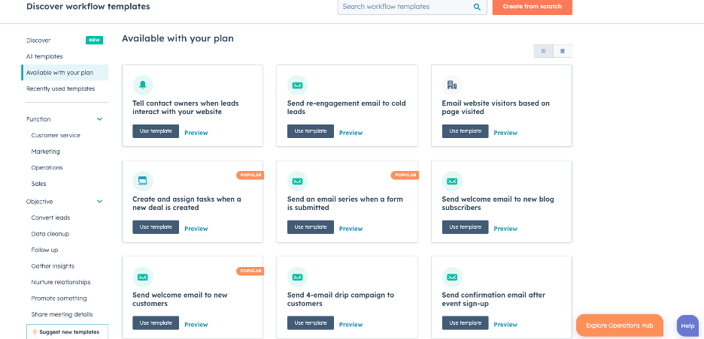
On the left menu, you can filter workflow templates by “all,” by ones “available with your plan,” and by “recently used.” If you’re planning on making a lot of similar workflows with some basic triggers and steps slightly altered to fit with different goals, the recently used tab will be your best friend.
Once you get some experience setting up your own custom workflows, setting up triggers, logic branches, and the like, then the “from scratch” option might be a good place to start—though there are often templates that do something close to what you’re planning on doing that can be adapted to your needs with minimal effort.
Step 4: Set up Your Workflow Triggers.
If you select “from scratch,” you’ll be taken to a screen like this:
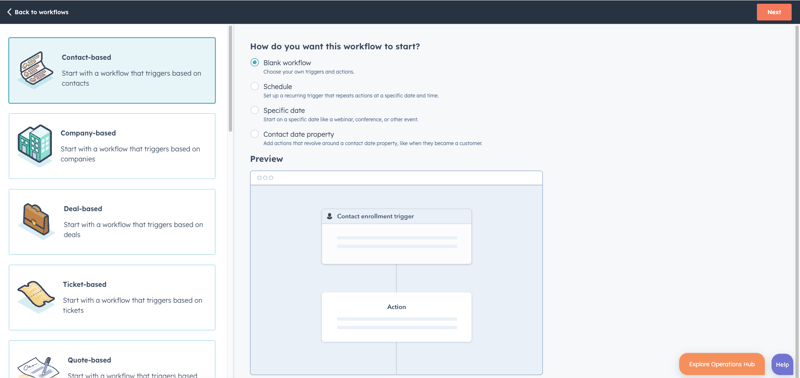
The from scratch choices provide more basic setups than the ones found in the pre-built templates but still cover a large variety of situations—everything from a truly blank slate template where you do everything yourself to templates for deals, feedback submissions, conversations, and more.
Let’s start with a completely blank workflow and set up a trigger:
In this clip, you can see me click on the “set up triggers” button. Then, I’m presented with a choice of what kind of trigger I want to use: an event-based trigger or one that is based on filter criteria for existing contacts.
For this demo, I click on “when an event occurs” since that is the type of trigger I often create to accompany landing pages for when someone fills out a form. If you know the type of event you want to base your workflow trigger on, you can type its name into the search bar. Otherwise, you can scroll down the list of trigger types on the left menu until you find the one that fits what you’re looking for.
Continuing with the theme of creating a trigger for a landing page, I click on “form submission” as the trigger event for this blog. I then click on “form fill” and am presented with a list of more options. Here, I want to get this workflow started for someone who fills out the “Agent Contact Landing Page (Website)” form, so I set it to “is any of” and click on the form name from the dropdown menu.
After that, I’m presented with the choice to add more triggers. If I wanted to do this, I could click on the “+ Add another trigger” button below where it says “OR” on the left menu. I also have to check whether contacts should be re-enrolled in this workflow if they meet the trigger criteria again.
For a form submission-based trigger, you can leave it as “no, only enroll each contact once,” as this is the default setting. There may be situations where you will want to re-enroll contacts again and again if they meet the trigger criteria, but not in this case.
Once you’re finished setting up your enrollment triggers, click “Save.”
Step 5: Add Your Actions.
Time for the meat and potatoes of the workflow creation process: Adding workflow actions!
You can start by clicking on the little + sign below your contact enrollment trigger on the screen:
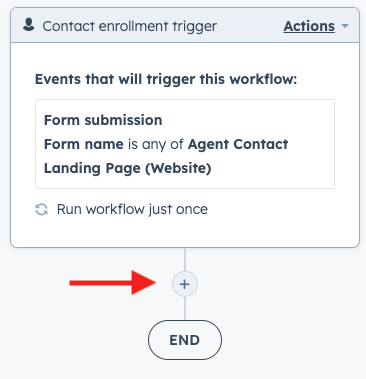
This will open a new menu for various actions that you can add on the left of your screen.
Different actions will do different things. For example, you can use the “delay” action to set a delay between any two actions in the workflow. A commonly selected delay type would be “set amount of time” to force a pause between two actions. This is often used to pace out email chains so contacts receive one email every few days rather than being bombarded with the entire email chain all at once.
Another type of delay you can create is the calendar date delay, which is useful for email workflows promoting an upcoming event. This allows you to create your email workflow months in advance, set it up in HubSpot, and let it run at the best time to promote it to your audience.
Other common action types include:
- Internal Communication. These actions are designed to send messages to members of your team to let them know about important actions taken by leads, prospects, and customers. Useful for ensuring that hot leads are followed up with after becoming sales qualified.
- External Communication. These actions send messages to people outside of your organization through various channels such as emails or WhatsApp messages. It can even be used to enroll prospects into another email sequence (or unenroll them).
- Assignment Actions. These put a contact record under the ownership of a member of your team—which may be useful for other workflow actions.
- Create Branch. You can create branches in your workflow to help it better engage specific contacts or address various situations. You could use an if/then branch to filter out contacts from a workflow based on their interactions with previous workflow steps—almost like a secondary trigger action within the workflow itself. If the contact does one action, then they get put down one path. If not, then they get moved down a different branch of the workflow.
- Record Management. These actions can create contact records or tasks. They can also be used to delete contacts as part of a contact cleanup workflow.
- List Management. Add or remove contacts to statics lists or change their marketing contact status in response to specific trigger criteria. The “set marketing contact status” action is a great tool for cleaning your contacts database and avoiding hitting your marketing contacts cap in HubSpot—potentially helping you save money on your HubSpot portal.
- Property Management. Set, copy, or clear property and company properties and values in response to workflow triggers. For example, if a customer downloads a “bottom of the funnel” content offer that indicates that they’re ready for a discussion with sales, you could change their status from “marketing qualified” to “sales qualified.”
Step 6: Repeat Until Your Workflow Is Complete!
Keep adding actions until you’ve completed the entirety of the workflow you want to create. Learn more about different action types in this HubSpot Knowledge Base article.
How Do I Manage Suppression and Unenrollment in HubSpot Workflows?
So, let’s say there are contacts in your database that you don’t want to include in your workflow, but may meet the enrollment criteria for your shiny new workflow. What can you do? You can build and associate suppression lists to your workflow or unenroll contacts from workflows using either manual or automatic processes.
Here’s how:
Setting Up Unenrollment Triggers in the Workflow
Creating unenrollment triggers in the workflow helps you automate the process of unenrolling contacts from the workflow so you don’t have to manually curate a list or constantly oversee who’s enrolled in the workflow.
You can use unenrollment triggers in a workflow to:
- Prevent currently unenrolled records from being enrolled if they later meet the enrollment triggers if they already meet the criteria for unenrollment.
- Unenroll currently-enrolled records from the workflow if they meet the unenrollment criteria after being enrolled.
- Unenroll records added after the workflow is turned on if they later meet the unenrollment criteria.
To add an unenrollment trigger to a workflow, you need to:
- Go to the workflow you want to edit.
- Click on the “settings” tab.
- On the sidebar, click on “unenrollment and suppression.
- Set your unenrollment trigger in the right pane.
If you use filter-based enrollment criteria, you can also set the workflow to unenroll contacts who stop meeting the criteria. Here’s a video showing an example of how to set up automatic unenrollment for a workflow with a filter trigger based on companies with 2,000 or more employees:
How to Create a Suppression List in HubSpot and Use It in a Workflow
Let’s say that you want to make sure that your emails from a workflow don’t go out to certain contacts—maybe because you’ve already marketed to them recently or because of other reasons. What can you do?
One thing that you can do is create a list of contacts you don’t want to enroll in your workflow in your HubSpot Contacts tool, then apply that list to your workflow as a suppression list.
To apply a list as a suppression list in your workflow, go to the “Settings” tab of your workflow tool, click on the “Unenrollment and suppression” tab on the left menu, then click on “suppression lists for this workflow,” and pick the suppression lists you want to add from the dropdown menu. Here’s a quick video tutorial:
What’s the Difference Between AND vs. OR Logic in HubSpot Workflows?
For many triggers and actions, you may see an option for an “AND” or an “OR” button below it.
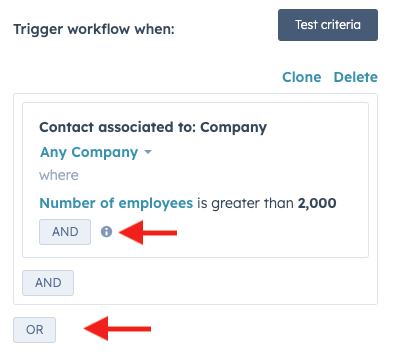
In this screenshot, you can see that, below the trigger criteria, you have a couple of “AND” buttons and an “OR” button. So, what’s the difference between these two options?
These are workflow logic settings that help modify your filters, unenrollment criteria, and other objects.
- AND Logic. This makes it so that, in order for the filter or enrollment criteria to apply to a property, that property must meet ALL of the logic for that filter/enrollment trigger.
- OR Logic. This makes it so that, if a property meets either enrollment criteria, then the filter or enrollment trigger will apply to them.
Let’s say you have a workflow that you want to send to every contact who is in the textile industry with more than 500 employees. In this case, you’d set a pair to enrollment triggers with AND logic: “Contact associated to company where number of employees is greater than 500” AND “Industry is equal to any of Textile.” This would help you make sure that the workflow is only engaging with the most relevant leads to the content of the workflow.
Now, let’s say you have a workflow to update contact properties in HubSpot so that anyone who fills out a form for a BOFU-oriented offer or schedules a meeting is set as a “sales qualified lead.” In this case, you would likely want to set an OR logic trigger to enroll them in the workflow.
Here’s a quick video example:
How to Manage Re-Enrollment in HubSpot Workflows
So, you’ve set your unenrollment triggers for your workflow, but you want to leave a way for leads to be re-enrolled in the workflow if they meet certain criteria in the future. The challenge is that, as noted in HubSpot’s knowledge base article on re-enrollment triggers, “By default, records are only enrolled in workflows the first time they meet the workflow enrollment triggers or are enrolled manually.”
This means that, once a lead is unenrolled from your workflow, they won’t be brought back into it if they later meet the enrollment criteria again. You could set up a new workflow to re-engage them or manually put them back into the workflow, but there’s a better solution—using re-enrollment triggers.
Here’s how you can add re-enrollment triggers to a contact-based workflow:
In this example, you’ll see that the enrollment trigger was based on two factors: The contact is a marketing contact and they have filled out a specific offer form on any website page. So, when I click the re-enrollment tab, you’ll see that I have the option to limit the re-enrollment criteria to either of the AND logic triggers.
Note: This applies to filter-based workflows, not event-based ones. With event-based re-enrollment, there is a question that says “Should contacts be re-enrolled in this workflow?” followed by two options:
- “No, only enroll each contact once.”
- “Yes, re-enroll every time the trigger occurs.”
When to Use Re-Enrollment Triggers
So, when should you apply re-enrollment to a HubSpot workflow? Not every workflow should use re-enrollment.
However, you might want to use re-enrollment for certain kinds of automation, such as setting contact properties when they take certain actions. For example, say you have a lead who is set as a marketing qualified lead (MQL) because they filled out a form for a middle-of-the-funnel offer, but were later unenrolled and lost their MQL status because they didn’t interact with your website or sales team for more than 180 days.
After being inactive, the lead takes another action that fits the enrollment trigger for that workflow. With re-enrollment on, they can be added to the workflow—setting them as an MQL again and indicating to the sales and marketing teams that the lead is ripe for further engagement.
What Are the Best HubSpot Workflow Templates to Use?
If you want to save some time on building your HubSpot workflows, there are numerous pre-built templates in the HubSpot portal that you can use. The “best” workflow template to use will depend on what you want to do and some of your automation plans might not have a template that they neatly fit into (yet).
So, you’ll want to familiarize yourself with a variety of templates based on how you most frequently interact with HubSpot. With this in mind, some of the best default HubSpot templates to use include:
1. Send an Email Series When a Form Is Submitted.
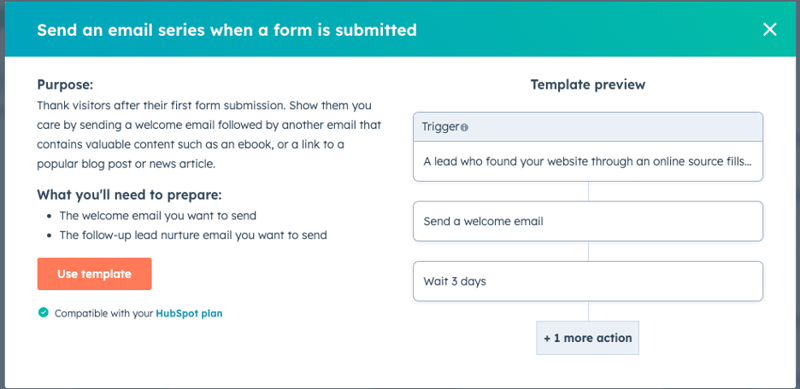
This is a great way to boost engagement with new leads on your site nearly as soon as they become leads. Many HubSpot users choose to use this for content offers by attaching the offer as a downloadable file or link to the download destination in the email this workflow generates.
2. Send Re-Engagement Email to Cold Leads.
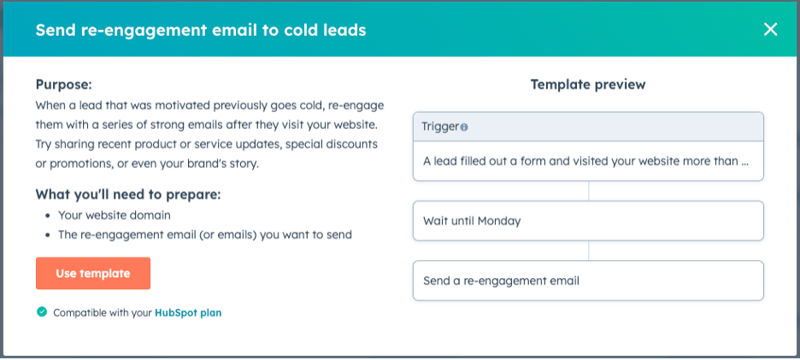
This template makes a great starting point for a re-engagement campaign for leads who haven’t interacted with your brand recently.
3. Create and Assign Tasks When a New Deal Is Created.
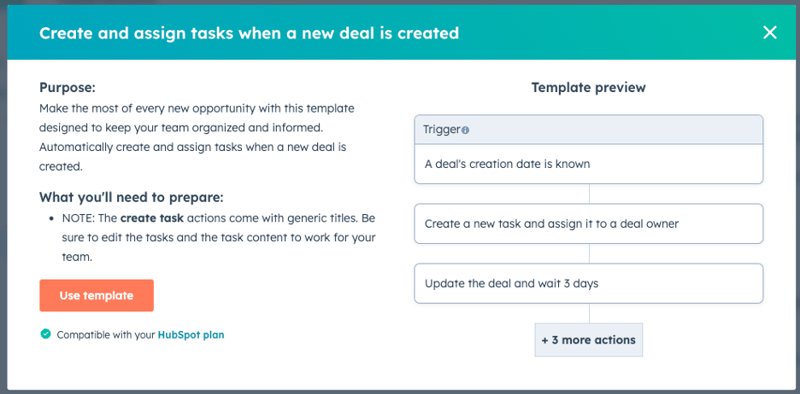
Help your customer service team hit the ground running when a new deal is created by automating the process of creating tasks for them in your HubSpot portal. This template serves as a starting point and will require heavy modification to align with your specific services.
4. Merge Duplicate Contacts That Share the Same Phone Number.
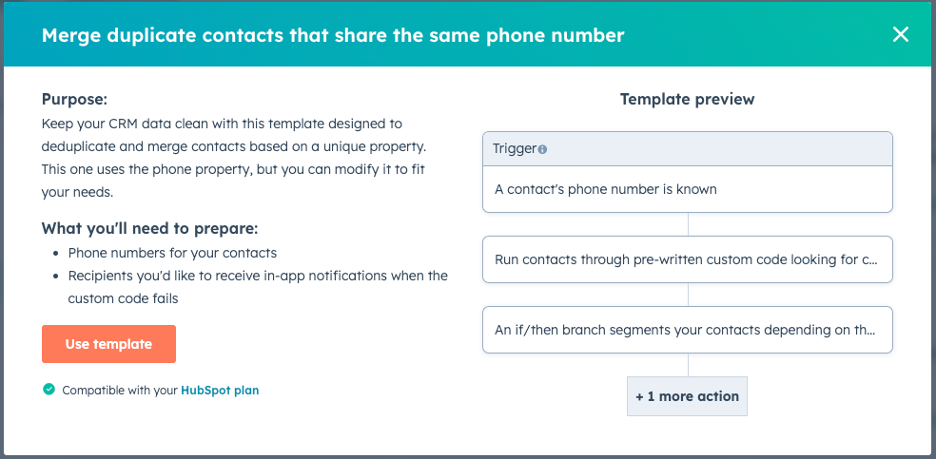
Duplicate contacts can be a major obstacle to the efficient management of your leads—causing issues like sending repeated communications to the same person, eating up your marketing contacts limit, and more. Cleanup workflows like this one help you eliminate redundant contacts in your system to save you time and headaches later.
5. Assign Contact to an Owner Based on Their U.S. Region.
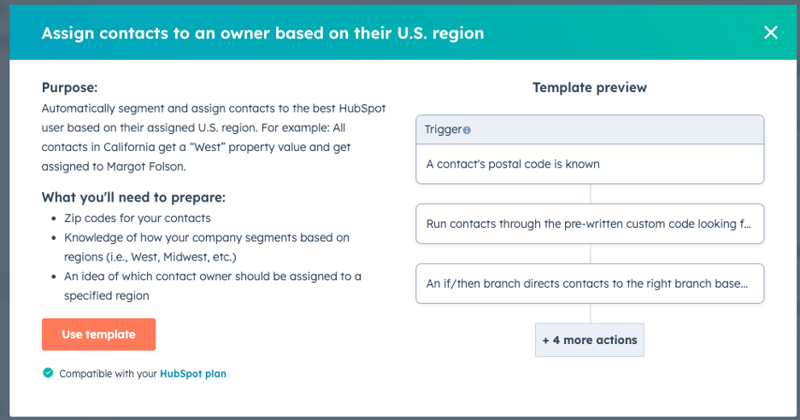
If you operate across multiple regions and have state- or region-specific service and sales teams for each area you operate in, this workflow template can be a lifesaver. With this, you can make sure that, when a lead in Dallas, TX becomes sales qualified, you can have your Texas-based sales rep be the one to reach out to them.
6. Customer Survey Drip Campaign.
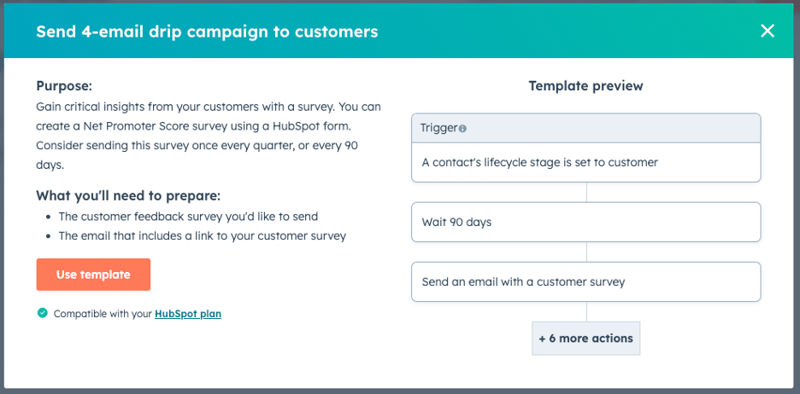
This is a template that HubSpot recommends for sending out customer surveys, but can be easily adapted to become a different email sequence.
For example, instead of sending an email with a survey, you could send emails upselling products and services related to the customer’s initial purchase, post-sale engagement emails to keep your company top-of-mind and generate goodwill, or even change the enrollment trigger to create a quick four-email chain on any topic you want.
How to Use Workflows for Your Internal Marketing Department
Odds are that, if you’re a marketer or are part of a marketing team for a business on the HubSpot platform, you’ll be making heavy use of HubSpot workflows in your daily tasks.
From setting up workflows to help promote new content offers to cleaning up your contacts database, generating follow-up reminders for your internal team, and changing lead qualification status as leads complete various actions with your brand, workflows can be a vital part of what you do.
The Top 5 Workflows You Need to Create for Your Marketing Department
- New Contact Email Workflows. For your marketing department, one of the first things you want to do is ensure that any new leads that your marketing efforts generate are followed up with promptly after becoming marketing contacts. Sources such as Podium state that “conversion rates are 8x higher in the first five minutes” of someone becoming a lead. Automation helps you achieve the near-immediate lead response times needed to move leads along your sales funnel into becoming customers.
- Lead Nurturing Workflows. As your customers complete various interactions with your brand, it’s important to keep them supplied with relevant information and resources that speak to their needs. While you could manually compose individual emails for each lead in your sales funnel, creating lead nurturing workflows that trigger on specific events is much faster and will save you tons of time on writing emails.
- Contact Cleanup Workflows. Managing your contacts database in HubSpot can be a daunting task—and it only gets harder as your list of contacts grows over time. Also, having too many marketing contacts can lead to hitting your marketing contact limits—resulting in your contacts tier being upgraded and increasing your HubSpot costs. Contact cleanup workflows that eliminate redundant contacts, move disengaged contacts to non-marketing contact status, and put contacts with bad email addresses into static bounce lists you can use to avoid sending emails to them (thus preserving your email domain’s health).
- Re-Engagement Workflows. Just because a lead goes cold doesn’t mean that you shouldn’t reach out to them ever again. Setting up re-engagement workflows for old leads can help remind them about your company and help pull them back into the sales funnel.
- Lead Status Updating Workflows. Manually reviewing each contact in your database to see which ones have taken all of the right actions to be considered marketing- or sales-qualified can be an enormous drain on your time. Using workflows to update lead statuses from nonqualified to marketing qualified and then sales qualified helps streamline your contacts management and saves you tons of time while helping ensure that you don’t miss a hot lead as they move from one stage of the sales funnel to the next.
How to Use HubSpot Workflows for Your Sales Team
Workflows can be a great tool for your sales team. With the right workflows, you can automate the setting of contact owners for your sales reps, keep them on top of hot leads, and score leads so they know which prospects are the best ones to pursue and which ones are less likely to bear fruit.
Here are a few things you can do with workflows for sales in HubSpot:
Sales Workflows: Triggering Lead Revisit Notification Workflows
If you have a Marketing Hub Professional or Enterprise account, you can generate lead notifications via email. All other accounts can get real-time alerts sent to their HubSpot activity feed.
For an individual user, the first step in this process is to have the HubSpot tracking code installed on your website. Then you:
- Click on the gear-shaped settings icon in the top HubSpot menu nav bar.
- Click on “Notifications” in the left menu.
- Browse the list of what you get notified about. There are over 20 categories of events to get notifications for, from ad interactions to workflow-related notifications.
This is the process for individual sales and marketing reps to get notifications about specific events that happen on your website or in your other marketing efforts. But what if you want to standardize the process for your whole team so nobody misses an important notification? This is where workflows can help.
Let’s start with the “Tell Team Members when a Form Is Submitted” workflow template:
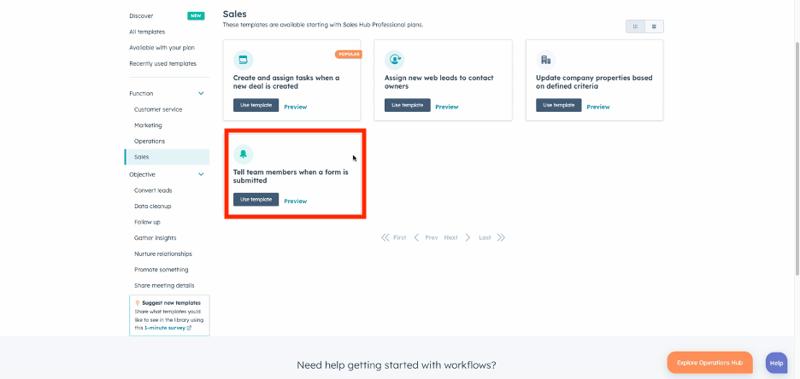
Here, you can see how easy it is to create a notification workflow. However, to really complete the process, I would need to either edit the message or the initial enrollment criteria as the notification defaults to a “[Contact Name] has booked a meeting” message and the enrollment defaults to a “contact has filled out any form on any page” trigger.
This is one thing to be careful of when setting up your HubSpot workflows. Using templates and defaults can save time, but they may not always line up with how you want to use the workflow, so it’s important to check your workflow triggers and actions before clicking on the “Turn On” button in the upper right!
Sales Workflows: How to Automate Sales Collateral Sends Through Pipeline Stages
Sending sales collateral to hot prospects at the right time can be critical for moving them smoothly down the last few phases of your sales funnel. But, how can you be sure that you’re sending the right collateral at the right time?
One way is to have the sales rep manually compile a sales email with relevant resources as they complete interactions with prospects. The issue is that this leaves a lot of room for error and the risk of a busy team member being late with their follow-up—plus it takes away time they could be using to close more deals.
Creating a set of workflows that trigger as prospects go through different steps of the sales pipeline is a faster and more consistent way to ensure that they get the right collateral at the right time.
How does this work? You can set up workflows with triggers based on contacts entering different phases of the pipeline.
For example, if a prospect in the “Project” pipeline moves up a stage, enroll them in a workflow that sends an email with a contextual sales asset relevant to the newest project pipeline stage they’ve entered. You can use an event-based workflow so that, when the prospect finishes the transition from one stage to the next, the appropriate sales material is sent.
Alternatively, say you have an existing customer who is on a subscription or retainer service that is up for renewal or is about to lapse. You could create an automated workflow that goes out to these leads a week or month (or any other timeframe of your choice) before the date of renewal to send them sales collateral related to the subscription or service they’re currently on.
Sales Workflows: How to Set Up Lead Assignment Automation
So, you have contacts that are ready to become leads that your sales team can follow up with. The question is, who gets to be in charge of managing each lead? If you have more than one salesperson on your team, then you’re going to want a way to easily assign each new lead to a “contact owner” who will be responsible for following up with that lead and closing the deal.
Workflows can be a great way to automate the lead assignment process. HubSpot has a couple of templates that you may find useful for this. For example, there’s the “Assign Contact to an Owner Based on Their U.S. Region” template that was mentioned above. Alternatively, you could use the “Assign New Web Leads to Contact Owners” template found in the “Sales” tab of the HubSpot Workflow Templates menu:
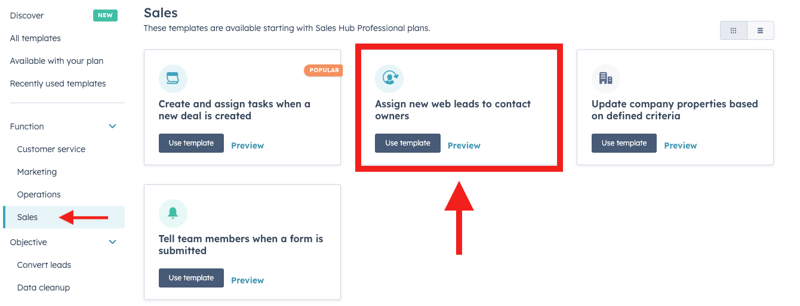
Once you’ve started your template, let’s go over how to set up an even distribution of contacts to various members of your team. Here’s a quick video:
In this example, I wanted to evenly distribute leads to the whole sales team, so I selected the “teams” option and selected the “sales” team in the dropdown.
If you wanted to, you could change the enrollment criteria to any action or filter status and use that to assign leads to specific salespeople. For example, say you had a sales rep specializing in onboarding for a specific service. You could create a workflow that assigns leads to that sales rep when they download a content offer related to that service.
Sales Workflows: How to Use Quote-Based Workflows
When a customer signs a quote, how can you ensure that the right onboarding steps are taken so they can be transitioned from sales to the customer service department? Creating a quote-based workflow can help you manage the hand-off process.
Here, you can start by using a trigger filter based on a quote being signed with a specific deal type (such as a “New Customer”) deal. Here’s a video showing the basic trigger for a “New Customer” deal type:
Why is it important to set both the quote signing and the deal type using AND logic? Because, if you used just the “signed quote” logic regardless of deal type, then every customer with a signed quote would be enrolled in this onboarding workflow. This might work if you have a single, one-size-fits-all solution, but won’t be suitable for a business with multiple product or service lines.
From here, you can set a variety of actions to follow up on this trigger. For example, you could:
- Send a “thank you” email to new customers that are from the sales or customer service team that outlines their next steps and basic preparations.
- Send messages to internal team members about the new client and what their expected next steps are to follow up with them.
- Reassign contact owners based on deal type from the sales team to the customer service team for future customer service workflows to trigger.
If you have a prospect who hasn’t signed a quote, you could create a filter-based trigger to send reminder emails to these prospects after a set period of time—such as a week or two after a quote has been sent.
Sales Workflows: How to Use Workflows for Lead Scoring
Even the best sales reps have limited time and energy for following up with leads. Finding ways to filter out bad prospects from your sales funnel so your sales team can focus their time on the best leads who are most likely to convert is critical for maximizing their success.
Lead scoring, the practice of assigning a point value to leads in your sales funnel as a general indicator of the likelihood that they’ll turn into a customer, is a useful tool for helping your sales team find the best leads to follow up with. HubSpot workflows can help you automate this process to make finding great leads (and avoiding terrible ones) easier.
HubSpot has a few properties built into their tool to help you simplify the creation of automated workflows based on lead scores:
- HubSpot Score. Available to Marketing Hub Professional and Enterprise Hub customers. You can customize this default setting in your HubSpot account from the Properties submenu of your HubSpot settings. Search for “HubSpot Score” in the properties menu, and click on the criteria in the list. From there, you can click on “+ Add criteria” in the positive or negative sections to add or remove points for specific actions.
- Likelihood to Close (Formerly Predictive Lead Scoring). Available to Marketing Hub Enterprise and Sales Hub Enterprise customers. This is an assessment of how likely a lead is to close a deal within the next 90 days.
- Contact Priority. This is a ranking of contacts based on their likelihood to close scores broken up across four tiers (Very High, High, Medium, and Low), with 25% of leads with likelihood to close scores being in each tier. Once a lead is set to being a customer in HubSpot, their contact priority is changed to “Closed/Won” and they’re removed from the tier lists.
While the HubSpot score is editable, the other two are not. Likelihood to close is based on HubSpot analytics and conversion data, their current lifecycle stage property, and HubSpot Insights tool information based on the contact’s company (if any).
Using this information, you can create workflows with triggers based on a prospect’s lead score to generate alerts to your sales team to follow up with them as soon as possible.
How to Use Workflows for Your Services Team
Workflows can be awesome for helping your services team improve efficiency and consistency of service. It’s just a matter of knowing which workflows to create to help your services team know what they need to do and when they need to do it, keep customers engaged, and collect feedback that can be used to improve services in the future.
Some services workflows that you may want to create in HubSpot include:
Services Workflows: Creating Ticketing Pipeline Automation for Your Services Team
Customer service request tickets can be incredibly time-sensitive—especially if you have a strict time-based service level agreement (SLA) with your clients that needs to be upheld. To help keep your service team on top of tickets, it can be helpful to create a ticketing pipeline automation workflow.
Note that this is somewhat separate from workflows, as it takes place in the “tickets” menu under the services tab of your HubSpot portal—though some users can integrate this into a workflow.
Tickets are a way for you to organize and track interactions with customers, and can be created by going through the service menu, clicking on “Tickets,” and clicking on the “Create Ticket” button.

This is a highly manual process, but it can be automated if you have a HubSpot Service Hub Starter, Professional, or Enterprise account subscription. Here’s how to get started:
- In the Settings (gear icon) menu, click on the Objects dropdown under the Data Management section of the left nav menu.
- Click on “Tickets.”
- Go to the Pipelines tab.
- Click the “select a pipeline” dropdown menu and click on the ticket pipeline you want to automate.
- Click on “automate.”
- Review and edit the settings that you’re presented with.
You can also get to this menu from the Tickets management tab under your HubSpot services menu. Here’s a quick video showing you how to get to the right menu from there:
From this menu, if you have workflow permissions on a Service Hub Professional or Enterprise account, you can then click on the “create workflow” buttons in the flow chart at the bottom of the pipelines menu under the heading “Additional status automation.”
If you cannot see the chart, click on the “Additional status automation” header to expand it. Not all users will have access to this menu, however. It depends on your subscription and workflow permission settings.
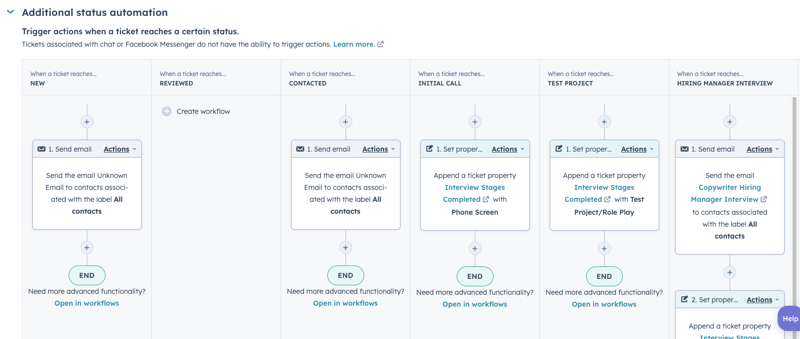
Services Workflows: How to Use Workflow Services Task Automation
So, you have a robust services team and a lot of clients for them to juggle. How can you help keep your team aware of important tasks so they don’t miss anything?
One way is to set up tasks in HubSpot to help your team keep track of their to-do lists. However, what if you need something repeatable so that all tasks for service pipelines are taken care of each time a ticket is created? This is where HubSpot Professional and Enterprise users can leverage workflows.
First, you’ll need to create a workflow based on the ticket status for the pipeline you want to create a task for—this can be done using the “+” button in the pipeline flow chart shown above or by going into the workflows tool and setting up a filter trigger for “ticket status” for the appropriate pipeline and clicking on the “+” button there.
You’ll get a sidebar menu showing you available actions for that ticket status stage and pipeline. In this case, we want to send a reminder email to the services team. So, we click on “send internal email notification” and set it to send to the ticket owner with a custom message related to that ticket.
Here’s an example:
You can then add further steps and tasks by clicking on the + buttons below this appropriate to each step of the service ticket pipeline in question.
Services Workflows: How to Use Workflows for NPS/CES/Feedback Surveys
You’ve delivered quality service to your customers, but what do they think about the services they’ve received? Are they happy with them? Is there room for improvement? Could they be a case study or act as a promoter for your brand? You won’t know for sure until you’ve collected their feedback!
This is where setting up a workflow for conducting customer surveys can help. With a customer feedback survey, you can get the feedback you need to assign net promoter score (NPS) values to customers and identify areas where your services could be improved to maximize customer satisfaction and NPS ratings in the future.
This is typically done from the service menu in your HubSpot navigation. Just click on feedback surveys from your HubSpot nav menu:
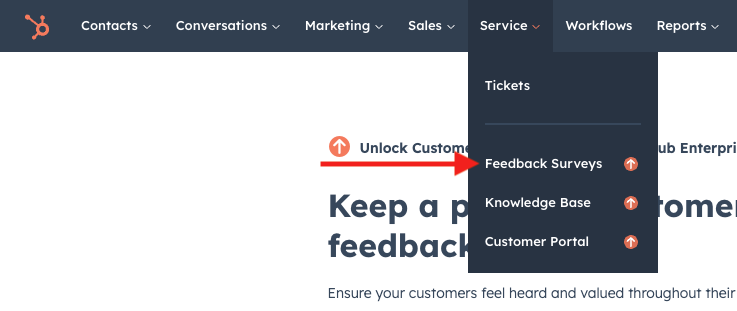
Note #1: You will need to have a Service Hub Professional or Enterprise account and permission from your HubSpot Account administrator to create a feedback survey.
From this menu, click on “Create Survey” in the upper right to make a new survey, click edit on an existing survey to modify it, or click “Clone” to copy an existing survey to base a new one off of.
From there, you can choose to create a web page survey or an email survey. Read the HubSpot article for more details.
Note #2: You cannot create workflows for customer surveys in the Workflows tab. It has to be done from this menu.
Wait, If This Is Done in the Services Tool, Where Do Workflows Come In?
While the editing of a survey workflow is done in the Services tool and cannot be accessed from the Workflows tool menu, the process for creating the survey and follow-up actions is very similar.
Also, you can create workflows that trigger based on a customer’s NPS/CES score in HubSpot to prompt them for potential other actions. For example, you could create a filter-based workflow trigger based on a customer’s last NPS survey rating for responses that were equal to any of a value from 9-10 to follow up with your highest-NPS-scoring customers.
This could be used to create follow-up tasks for your team, send the satisfied customer a thank you email, or even try to prompt them to leave a review for your business on a review website.
Using Workflows for Your HR Team
So, you have a successful business that you want to keep growing. Odds are, you’re going to need more people and keep the people you have happy! This is where creating HR workflows can help!
For example, HR workflows can be useful for helping you set up employee recognition initiatives and creating or managing tasks for hiring new employees.
HR Workflows: Using Workflows to Celebrate Anniversaries and Other Milestones
Employee recognition is an enormous component of any workplace productivity and employee retention setup. Quantum Workplace notes that “When employees believe they will be recognized, they are 2.7x more likely to be highly engaged” at work. This drives productivity and reduces the likelihood that employees will voluntarily leave for other career opportunities.
You can use a contact-based workflow to target your employees centered on specific dates or contact date properties you keep track of in your HubSpot tool. Here’s a simple example of a workflow to send to HR to remind them when an employee reaches the 90-day mark after becoming a new hire.
This simple starting point will send a reminder to your HR team whenever an employee clears the 90-day trial employment period. You could also create longer delays for anniversaries, base delays on specific employee events (such as earning HubSpot Academy certifications), birthdays, and other contact properties that you create in your HubSpot portal.
HR Workflows: Setting Up Workflows Based on Hiring Stages
You can work your workflows into your talent acquisition process by using hiring stages in your workflow triggers to make tasks for your HR team.
Here’s a quick video example of a simple internal HR notification and task creation workflow for when a potential new hire clears the first round of review:
Note: In this example, you’ll see that we used a few custom properties not present in the base HubSpot portal. You’ll need to create and edit contact properties for this before you create your own hire stage-based workflow.
Essential HubSpot Workflow Resources
Looking for additional HubSpot Workflow resources? Here are links to a variety of resources about the workflows tool that you can reference during your workflow creation process:
Reference Links:
- HubSpot Academy: Workflows
- Organizing and Streamlining Workflows in HubSpot
- Workflows Deep Dive
- Understanding Workflows in HubSpot
- How to Delight Customers Using Workflows
- Using Workflows to Power Your Inbound Strategy
- Building an Effective Automation Strategy in HubSpot
- Creating a Lead Nurturing Workflow
- Connect Business Processes to Workflow Actions
- HubSpot Knowledge Base: Workflows
- Create Workflows
- Create a Workflow from Scratch
- Organizing Your Workflows
- Creating Scheduled Workflows
- Creating Specific Date or Contact Date Property Workflows
- Creating a Workflow From a Template
- Setting Enrollment Triggers in Workflows
- Adding Re-enrollment Triggers to Workflows
- Choosing Your Workflow Actions
- Manage Your Workflow Settings
- View Workflow History
- HubSpot Community: Workflows
Save Time on Building Workflows by Reaching Out to the HubSpot Experts
As an Elite Solutions Partner, Bluleadz has the highest amount of reviews in the HubSpot directory. We’re a HubSpot onboarding and implementation agency that not only helps you get started with your portal, but also helps you manage your tools moving forward to achieve your goals.
If you have any questions about the HubSpot workflows tool or are looking for help with your HubSpot portal, reach out to Bluleadz today! We look forward to helping you get the most out of your HubSpot subscription and transforming the way you market your business and serve your customers.

Douglas Phillips
Former military brat, graduated from Leilehua High School in Wahiawa, Hawaii in 2001. After earning my Bachelor's in English/Professional Writing, took on a job as a writer here at Bluleadz.